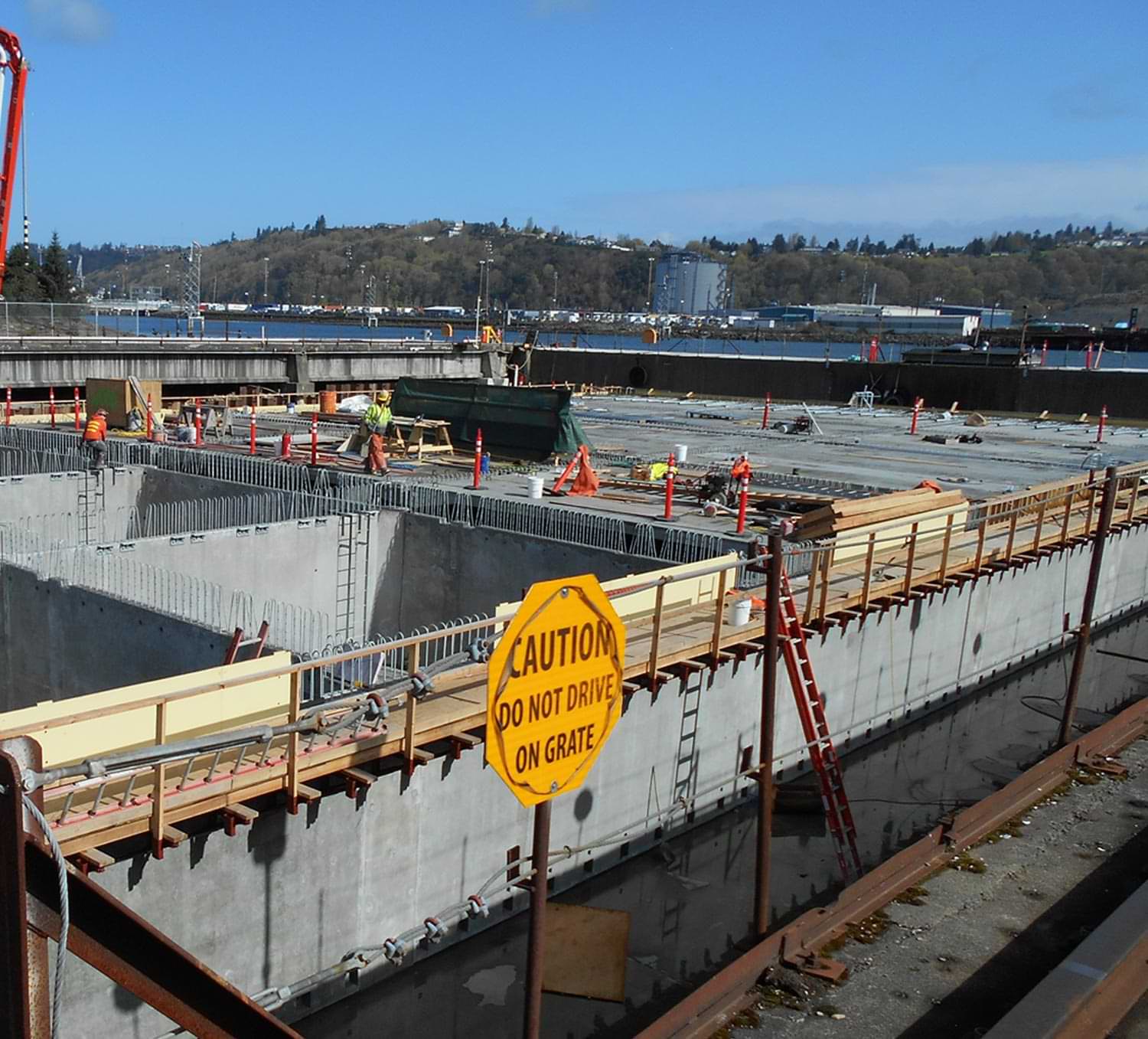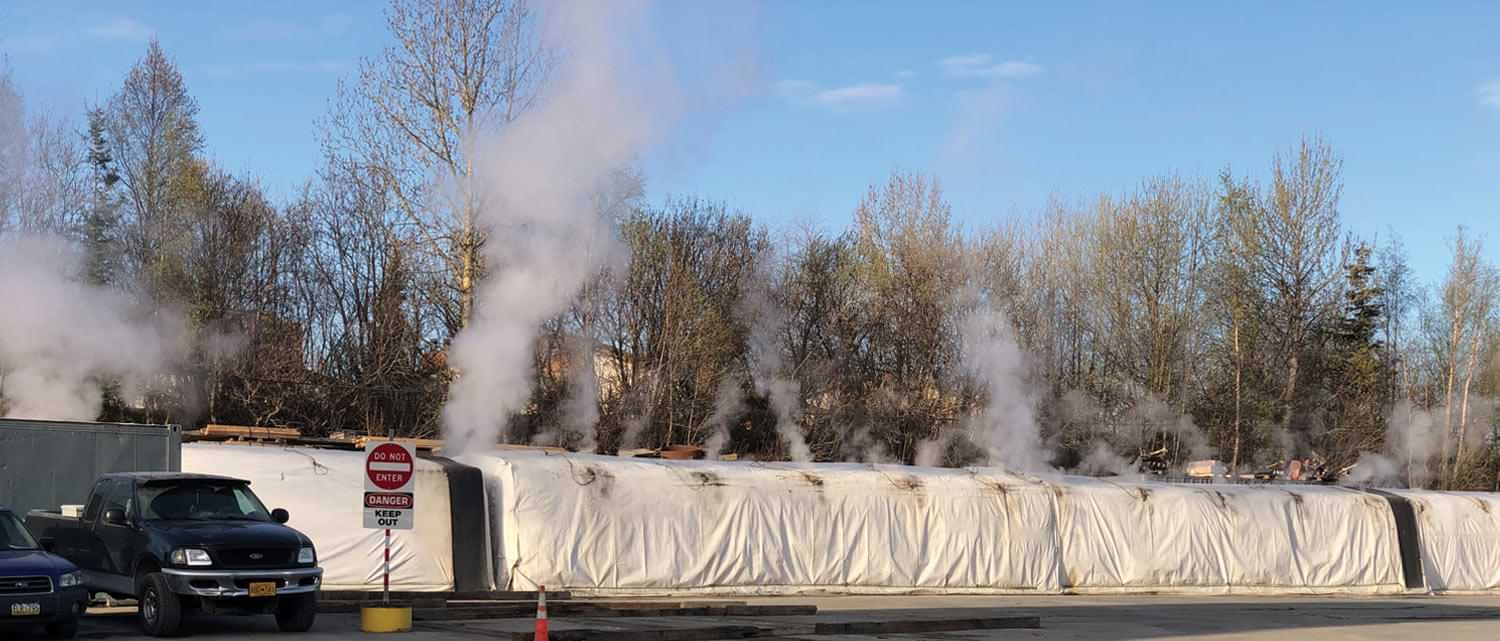oncrete is the foundation of modern civilization. This ancient construction material is as much a part of the modern urban landscape as wood, brick, steel, and asphalt. Its ingredients are simple: water, cement, aggregate (sand and gravel), and air. However, strength and durability depend on the mix-design as much as proper application and curing. Done correctly, concrete structures can last a lifetime or, in the case of the Roman Pantheon and Colosseum, outlast the culture that built them. Despite its staying power, manufacturers and mix-designers are always looking for ways to improve concrete for enhanced performance and environmental sustainability.
Concrete is frequently used for bridge construction because it has fewer future inspection and maintenance requirements than steel and materials often can be sourced locally. Contractors used precast concrete and reinforced steel to complete the Gravina pedestrian bridge.
Richard Giessel | DOT&PF
Richard Giessel | DOT&PF

Concrete is used in many ways in commercial and residential construction projects. As building material, concrete is used for foundations, superstructures, columns, driveways, floor construction, and exterior surfaces. For infrastructure, concrete is used to build bridges, dams, wastewater treatment facilities, traffic guides/barriers, sidewalks and curbs, and parking lots/structures. Concrete roads and highways are rarely found in Alaska, though they are more common in the Lower 48.
Davis Block & Concrete supplies precast items, landscape pavers, retaining walls, masonry units, and bulk bags of materials blended to specification. Davis says his company relies on experience and technology to assist clients with their ready-mix concrete services. In addition to a computerized batching system, it also provides concrete pump trucking services for quicker, less labor-intensive pours at a job site. The company also developed a Remote Concrete Division with an in-house trucking fleet, a mobile concrete batch plant, and materials storage that can be set up at job sites much farther away from the home office in Kenai.
“Technology has played a role in increasing portability, mix accuracy, and application,” says Davis.
Along with technology, Davis says materials testing protocols have increased, particularly with state and federal projects. Different testing methods are used to measure the air, slump, and unit weight prior to application, as well as strength after it has dried.
Given the competitive nature of the industry, Davis says manufacturers generally don’t share how much concrete they typically produce in a year, but he did reference a single large project for which Davis completed up to 40,000 cubic yards in one year.
Room for Improvement
Giessel says the general approach to concrete changed little between the time of ancient Rome until the ‘30s, when one of the most significant innovations in concrete technology occurred. Engineers had noted that certain concrete pavements better withstood freeze and thaw cycles than others. After investigation, they discovered that the most durable pavements were less dense, and the cement came from a mill that used beef tallow as a grinding aid. The tallow acted as an air-entrained admixture, creating tiny air bubbles that gave the concrete more room for expansion and contraction and was therefore less susceptible to cracking from freeze/thaw. Until the mid-’90s, the most-used air-entrained admixture was neutralized wood resin. Now manufacturers lean toward synthetic detergents like salts of organic acid and sulfonated hydrocarbons, which have improved stability since the ‘30s.
More recently, Giessel says engineers are looking at the benefits of using fly ash in concrete. Fly ash is a fine powder that is a byproduct of burning pulverized coal. As a pozzolan, fly ash contains aluminous and siliceous material that forms cement in the presence of water. Mixed with lime and water, the compound is similar to portland cement. When used in concrete, fly ash improves its ability to resist water infiltration and its strength while making it easier to pump.
Giessel says aside from increased strength, there are many reasons to incorporate fly ash. Since it reduces CO2 emissions and uses a lower water/cement ratio for similar slumps, fly ash is considered environmentally friendly. It is cold weather resistant, which is extremely important in Alaska; has a high workability; is considered a non-shrink material; and produces dense concrete with a smooth surface and sharp detail.
There are drawbacks, though. Fly ash concrete has a longer setting and curing time, which means slower strength gain; it has seasonal limitations as to when it can be poured; and it’s more difficult to control the color variability. Despite this, Giessel says fly ash concrete may provide the durability and strength that increases the longevity of finished products.
Several curing methodologies exist depending on the finished product. Steam curing this bridge girder overnight at an AGGPRO Production facility resulted in a finished product with the strength of 7,000 psi.
Richard Giessel | DOT&PF
Richard Giessel | DOT&PF

The Alaska Concrete Alliance is currently discussing the difference between prescriptive-based and performance-based concrete specifications. Engineers wrote prescriptive-based specifications decades ago when quality control standards were just being developed. Prescriptive specifications include clauses for the methods of construction and impose restrictions on the compositional parameters of concrete mix. For instance, a specified minimum amount of cement content, requiring the use of brands or sources of materials, or restrictions on adjustments to mix proportions as needed.
As quality control standards evolve, many in the engineering community are advocating for a move to performance-based concrete specifications. Performance specifications don’t rely on parameters like components or proportion of the mixture. Instead, they are based on performance indicators like strength, permeability, shrinkage, sulfate resistance, et cetera. Indicators are measured by standard test methods with defined acceptance criteria.
“It’s something I hope we can get changed,” says Giessel.
Workmanship Matters
“Concrete construction is something everyone thinks they can do until they get to the actual job site,” says Scott.
He explains that finishing concrete is more than just waiting for it to dry once it’s poured. Cement masons smooth and compact it and then apply curing compounds to prevent moisture loss while the concrete is gaining strength. There are many ways to place and finish concrete depending on the desired look. In addition to hand trowel, broom, and exposed aggregate, cement masons can make concrete look like any natural material, such as slate, brick, wood, or stone. They can also color, stain, polish, and stencil concrete or apply decorative and commercial toppings of epoxy, acrylic, or polymer-based floor installations.
“You only have so much time to complete the surfacing texture and detail,” says Scott. “I tell people concrete will not wait for you. In the event you don’t finish it in time, it ends up costing a lot to try to resurface it and could end up being a liability.”
Scott says the 135 members in Local 528 Alaska work on hundreds of projects every year statewide. Most of them are public infrastructure projects like curb and gutter, building foundations, airport taxiways, and concrete utility facilities. Like Giessel, Scott sees future mix designs and admixture chemicals resulting in more environmentally friendly concrete.
How concrete is poured is also changing in ways that ancient Romans could never have imagined. Computer-driven 3D printers can squirt concrete into precise shapes, even at the scale of whole buildings. However, Scott believes the size and amount of equipment needed limits the feasibility of 3D printing concrete.
“You’ll always need some element of manual labor to finish concrete,” says Scott. “It’s not a job that’s going to be lost to a computer.” ![]()